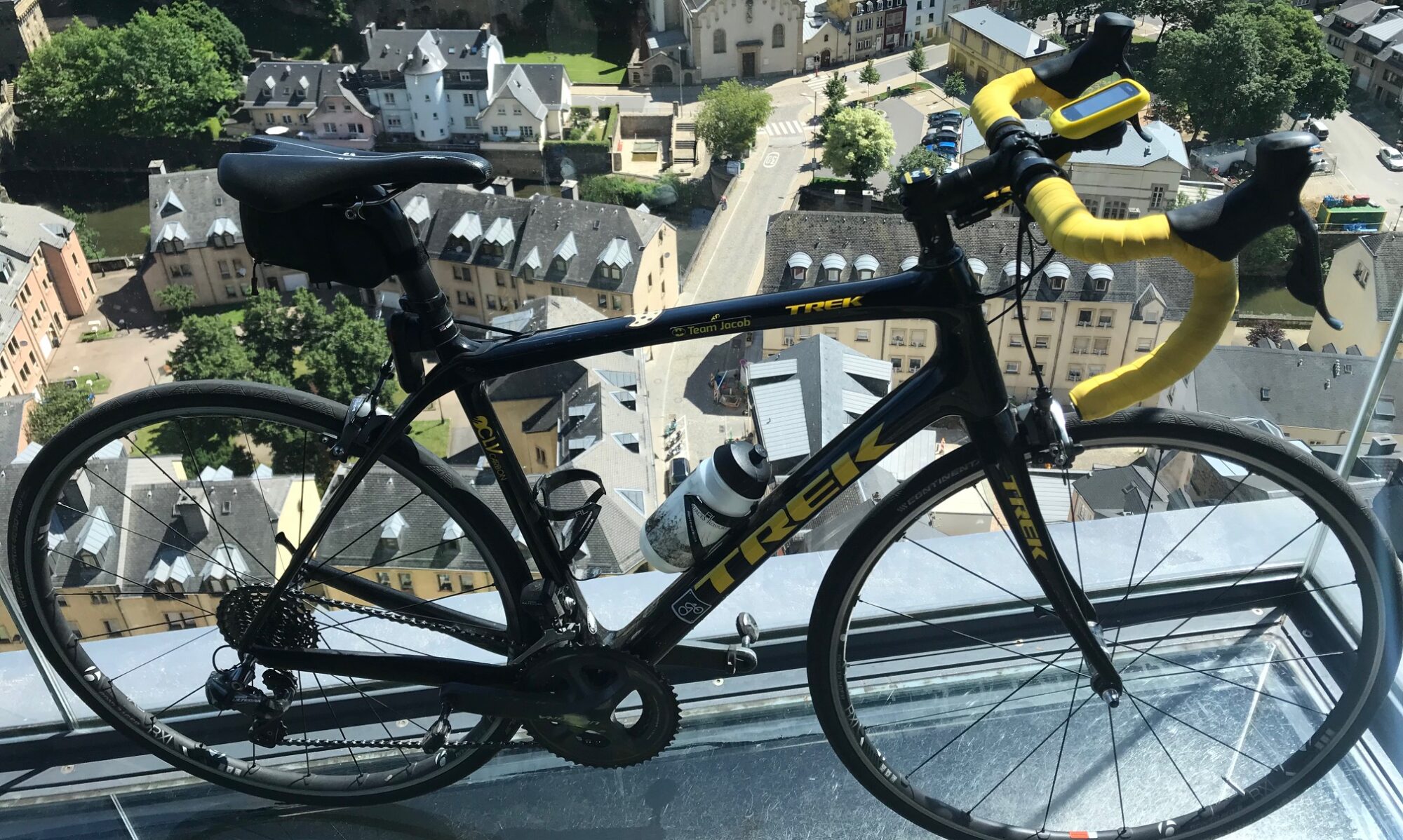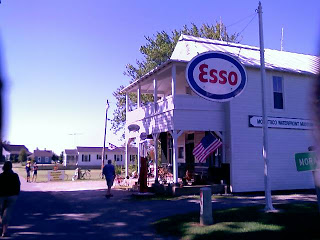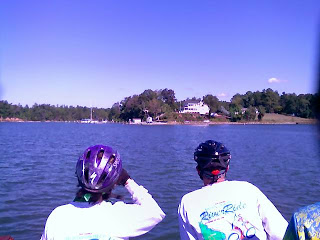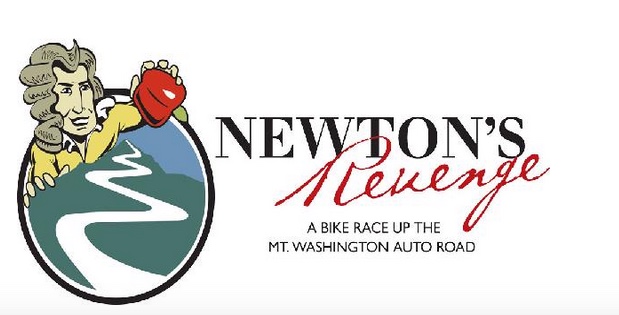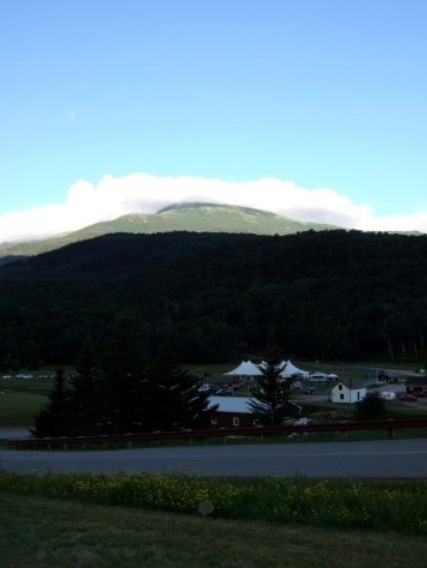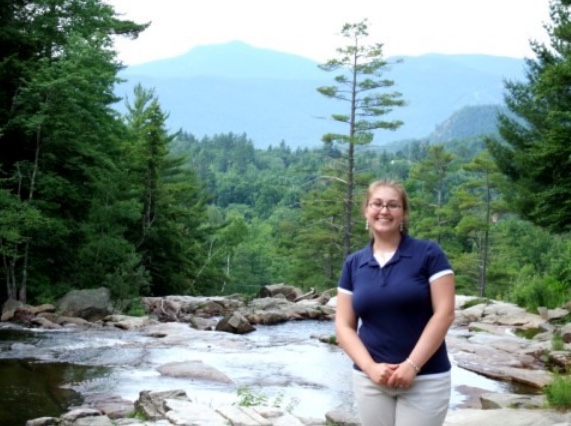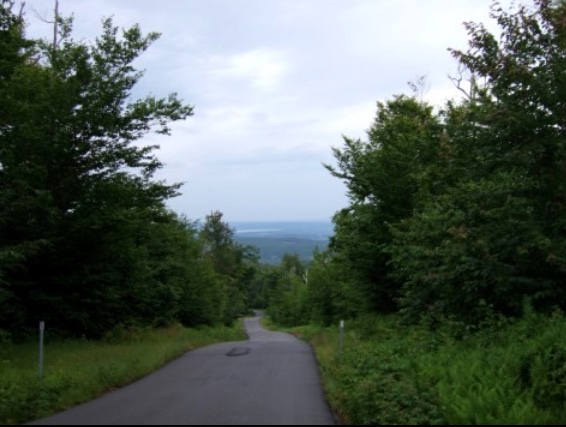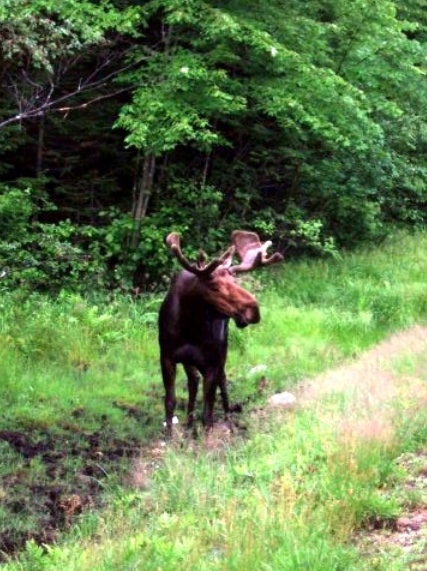“Italy has its Mortirolo, mountain of death; 124 persons to date have died on Mount Washington. Overall steeper than the Angliru, windier than Mont Ventoux, deadlier than the mountain of death; this is why for cyclists, Mount Washington stands above all other climbs. It is not hard just because it is steep. It is also windy and cold enough to be dangerous.” — New York Cycle Club
PINKHAM NOTCH, NEW HAMPSHIRE

I was up before 6:00 a.m. in part because I didn’t sleep well. It was OK, but not great. The thought of riding up the Mount Washington Auto Road certainly weighed heavily on my mind during the night. This is known simply as the toughest climb in the world. Almost 8 miles 1 in length, an average of 12% grade, and 22% at the top. If that’s not bad enough, high winds and cold weather almost always greet riders above the tree line.
Why I was even here was being replayed in my mind. Unlike many real climbers, I don’t weigh 140 or 150 pounds 2 but yet there is something rewarding being a climber. And even if I don’t have 20 or 30-year-old legs, mine are 50+, there is a reward of accomplishment every time one crests a hill, especially a large hill.
If I were to accomplish this it would be a physical triumph. For more than 10 years I had a pronounced limp after any exercise and often even without exercising. Getting out of bed in the morning to the shower usually involved crawling or bracing myself along the wall. I had foot surgeries in 2003 and 2004 which included taking a wedge out of my right heel, rotating it upward, then securing it with a three-inch titanium screw. Then two years ago I had knee surgery too.
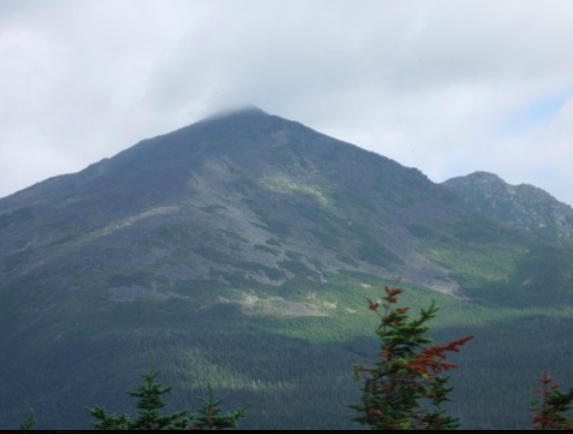
I finally felt better and I had wanted to go to Europe, France especially, and ride some of their great mountains. But the more I read about Alpe d’Huez and other climbs the more I discovered there seemed to be a consensus that there is a better climb here in the U.S.: Mount Washington. And I could drive there as well.
With the biological climbing clock ticking, I made arrangements to climb Mt. Washington last year. Never mind that I never entered a race or hill climb race before. I would go to New Hampshire and climb the toughest mountain of all. But last year’s races were canceled so I found myself back in New Hampshire. It was scary to think that it was now just two hours away.
We loaded both bicycles (my daughter, Ashley, had hers with her although she wasn’t riding the mountain) and were almost out the door. In the breakfast area of the hotel, I saw two bikes, one was geared very low and the other was geared normal, like mine.
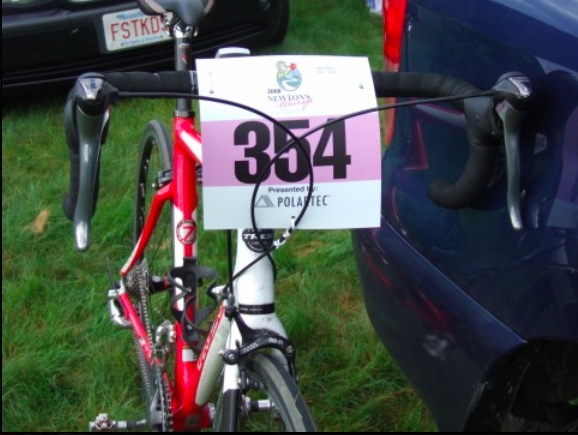
Trek Pilot 5.0
Triple front crank, 30/39/50t — 10 speed 12-27t rear cassette
Not a 1:1 ratio — would that be low enough?
For weeks I debated, mostly with myself, as to whether or not I could make this climb with the gearing I had. On the Mt. Washington biking forums, the predominant opinion seemed to be one must have a 1:1 gear ratio. That is if you had a 30 tooth ring in the front you needed 30 in the rear. I didn’t have that. I had 30 in the front but only 27 in the rear.
It’s not a simple change. The derailleurs and chain may have to be changed, if there is clearance, to accommodate a smaller front ring or larger rear cassette. Add to that, you ask 10 different riders and gearheads and you get 10 different answers on how to do it, why one can’t do it, and whether you need to do it at all. The simple answer always was “it depends on the rider.” The pros, of course, don’t need these low gears but as one gets older they may be necessary to help lesser riders up a mountain.
As the time got closer, I hadn’t made any changing to the gearing, and the closer to race day the less sense it made. One should ride quite a bit in a new setup to make sure everything is working properly. I ran out of time. Plus it was more than that. I looked at the bikes with the 22 tooth front sprockets as somehow cheating. If they weren’t going to ride their normal geared bike it didn’t seem quite right they could make it super easy to pedal. Well, easier to pedal.
I looked at the rider who had changed his gearing. I didn’t say a word to him, just looked. Sized him up a little. He was about my age and I thought, “ah hah, you can’t make it with your normal gearing.” Then I wondered if I could.
But then I spotted the normal geared bike. The rider had a rider jersey on with pajama bottoms, an obvious sign of a 20-year-old. I told him I was glad to see that he didn’t mess with his gearing and he responded that he races mountain bikes. Well, that didn’t help my confidence at all.
We drove out to Mt. Washington. Last year Ashley and I made this trip three times. Once to register on Friday, once to race on Saturday (canceled), and once to race on Sunday (canceled again). At race start time in 2007, the winds on the summit were 70 mph 3 with a temperature in the high 30s 4. The wind chill was below freezing. Zero visibility. It is with pride that Mount Washington claims the title as the world’s worst weather.
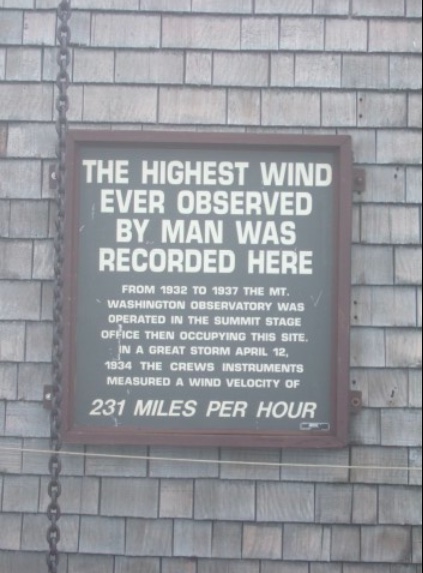
While we had fun last year coming to Newton’s Revenge, Ashley’s big desire was to see a moose. And though I didn’t get to ride Mt. Washington Saturday or on the Sunday rain date, we did see our moose. Our trip was a partial success.
This year it may not have been a goal but Ashley’s husband, Bryan, was with us and had never seen a moose. Yesterday we went out to Mt. Washington to register and saw our moose. Maybe it was a good sign.
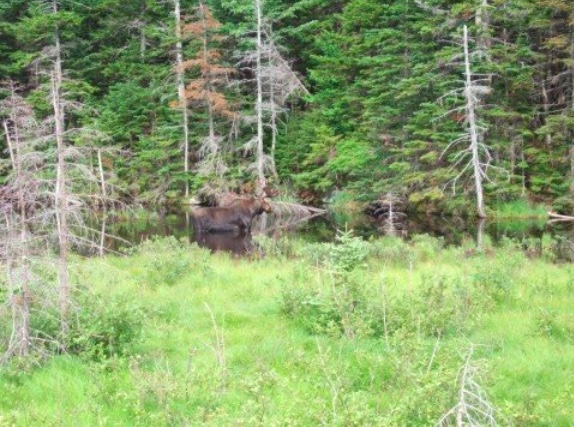
We arrived at the site amid excitement. We parked and unloaded my bike. One rider borrowed my pump (he was unprepared) and another asked if we had an extra wheel (not a tube — but a wheel).
I still had one nagging thought. On Tuesday I played Ultimate (Frisbee) with the normal gang of lunchtime idiots on the Mall in Washington, D.C. On what should have been a normal play, Rich Preston, an overly large person (big bone – not fat) who is built more like Big Bird than an Ultimate player, somehow got his knee up into my quadriceps. I instantly went down. Months of training and years of dreams flashed before my eyes as I felt a sharp pain and could not walk.
I tried to stretch and massage it for a while before returning and finishing the game. But the key test would be getting on the bike and riding the bike to work. I couldn’t. Every pedal stroke hurt and I knew that’s where I would get my power to climb the mountain.
Tuesday evening I just tried to “spin” it out, riding very lightly in the neighborhood. There wasn’t power there. I tried the same Wednesday morning and still felt it. Thursday in Connecticut it began to feel better and I only hoped that while it didn’t seem to hurt anymore, there would be power reserves in my leg when I needed them.

We spent a few minutes chatting and checking the bike. Ashley gave me a hug and she and Bryan got in line to drive to the top before the road was closed at 8:00 a.m. I rode a little in the grass, circling them, then finally headed up and across the road and joined about 50 others riding loops in the parking lot at the Glen House across the highway.
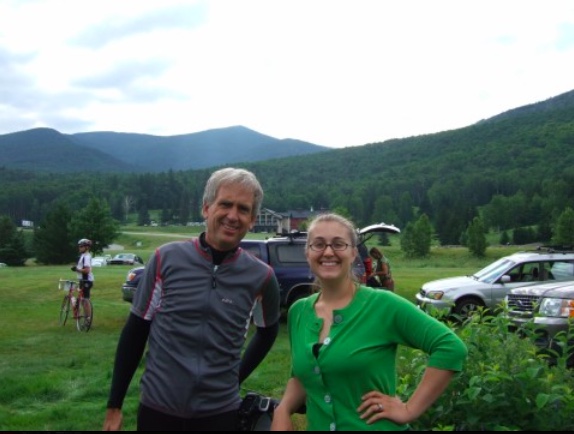
I did that for about 25 minutes to warm up my legs and get my heart rate up a little. It was chilly at the start. I was in my jersey and another rider asked me if that was all I was wearing. I told him I was unsure and he had lots of warm gear on. The more I thought about it I decided to wear a long sleeve Under Armour under my jersey. I had thought about wearing arm warmers but decided it was better to wear something on my core as well. The Under Armour would wick away moisture but keep me warm when I reached the cold summit. That was the last Ashley and Bryan saw me — decked out in my warm riding gear.
By starting time at 8:30 we were told that it would be 50º (10º C) with 25 mph 7 winds at the summit and that our body temperature would be about 115º 8 when we arrived. I decided to remove the Under Armour.
(Actually, the core temperature may rise to about 100º – I suspect the race announcer was just being a little bit dramatic.)
Four groups lined up at the start. The first was the Top Notch group included defending champions and pro riders. One was Anthony Colby, a rider with Colavita/Sutter Home racing team. The announcer told everyone that Anthony would win the race. Talk about incentives for the challengers.
The remaining groups were lined up by age. The second was the 20 and 30-year-olds. The third was the 40-44-year-old group. The last group was 45+ — the old group. I took my place at the end of this largest group. I was literally the last person to start.
My goals were simple.
- Finish.
- Finish ahead of the Sag (Broom) Wagon. Even finishing last (Lanterne Rouge) would be sort of cool as long as I finished.
- Don’t stop. Although I reluctantly made a deal with myself that stopping and resting was better than not finishing, so if I had to, I would. But don’t.
- Don’t walk. Again, walking was better than not finishing but try to stay on the bike.
- Under two hours? I had no time goal but thought I would be in the 1:40-1:50 range.

On Thursday I had ridden Hurricane Mountain Road and failed to get up that two-mile 16-18% climb without a brief stop. (See Blog Doubt Sets In) I did another test ride Friday and went slower seeing if riding slow and steady would conserve the energy I had. It did and that would be my strategy for climbing the “Rockpile.”
Each group lined up when called. The official timing was done by satellite clock so that the finishing clock at the summit and the starting gun would both be at 0:00 (time elapsed) at 8:40 a.m. (time of day). At 8:39:50 the countdown began. Ten, nine, eight until it reached zero and a cannon fired the official start at 8:40:00. The remaining groups went at five-minute intervals, each receiving a cannon send-off.
At 8:55:00 the cannon fired to start our group. Some riders took off trying to be the first to climb the hill. I went slowly to test my legs and conserve energy. I was content to finish last as long as I finished.
Almost immediately I passed some of the bikes that were geared very low. They were spinning. I was mashing. I figured I would envy their low gearing later. We started climbing the first mile which I read was pretty difficult and scares a lot of riders.
I wanted to stay seated as long as possible knowing that standing uses more energy than sitting. But in a half-mile, my body was already begging me to get out of the saddle but it seemed no one around me was. Then I looked and saw a couple of riders standing and I did too. I alternated sitting and standing as we climbed never concerned about anyone else. I just rode at my own pace.
Near the end of the first mile, one rider stopped and started walking. He was a “Clydesdale,” a designation for a rider who weighed at least 190 pounds 9. Although I gave him encouraging words, he told me his heart rate was in the red zone. He was wise to take a break. He may have abandoned the climb but that is better than harming oneself.
As we climbed higher, I seemingly was stuck in with a group of about 10 riders all, more or less, my pace. At every mile, there was a volunteer who told us where we were. They seemed to always be at a mile marker so it was a nice touch but since I could read I could usually figure it out.
My decision to jettison clothing was a wise one. I was glad to get rid of the Under Armour before the start. But with every turn of the pedals, I was second-guessing my training. Was it enough? Sure, I rode in the Blue Ridge Mountains in Virginia and the Laurel Mountains in Pennsylvania but was that enough preparation?
I even shaved my legs to give myself one more mental edge that might help me complete the climb. I admired how the sweat was dripping on my smooth legs and liked the look. Almost everyone on the Top Notch group that went first had shaved legs. There weren’t so many in our fourth group.
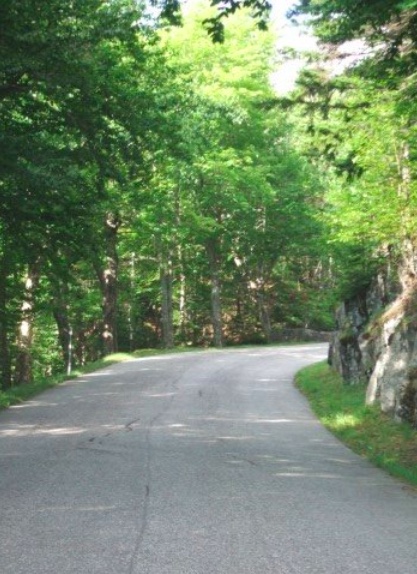
But the sweat also meant my gloves were soon soaked. I didn’t need the protection of gloves on an eight-mile ride and I struggled to remove those as well. There are many things you can do on a bike on a flat or downhill section but those become much harder while climbing. Drinking can be one of them. Removing gloves is another but I was able to alternate between slipping a finger out, grabbing the handlebar, pulling a little more until I got both off and back in my jersey pocket.
We were still occasionally talking with other riders but that would not last all the way to the top. One person asked why the 45+ group was the largest and another rider opined “mid-life crisis.” I suggested we were much closer to the end of the timeline than the 20-somethings and we still have that list of 50 things to do before you die. Bike up Mt. Washington. One rider referred to a movie, The Bucket List, which I hadn’t seen but now will have to watch.
The last bit of friendly conversation came from Catherine Reed. She remarked that if we could take a second we could enjoy the beauty of the climb in a way we never see by car. The lower section was tree-lined and was beautiful, the higher sections one could see for miles.
But it was to turn serious and the talking would cease. This was not due to competition between the riders. It was simply the air was getting thinner and the effort was wearing on the riders. There simply wasn’t energy left for meaningless conversation.
Only once did I really look out over the valley. I was at the 4,000 foot level and could turn, briefly, and see the huge tent next to the gatehouse where we had started. It truly was like flying and looking out an airplane window. And if my skinny front wheel ventured too close to the edge, I could be flying too. I turned back to watch the road.
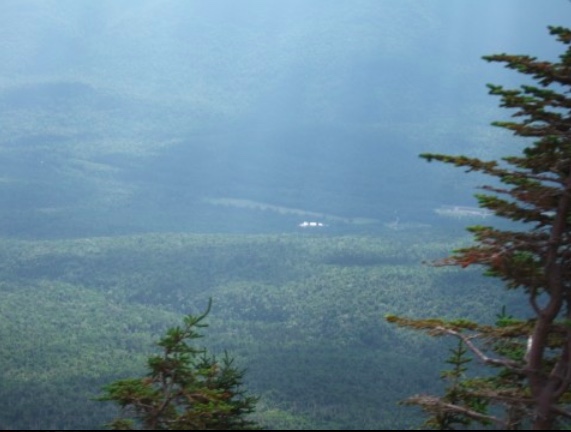
(that tent down there)
While still in the trees on the lower part of the course it was still hot. And I didn’t have enough water. One needs to balance how much to carry as opposed to how much extra weight is on the bike. This is a race where riders have been known to remove both brakes from their bike to remove weight (although not permitted). There are no downhill sections, none, and one cannot ride back down the mountain. Brakes? Who needs them
I had searched the rider forums and had decided on taking one water bottle. But I had already drunk half during my warm-up. I had started the race with half a bottle of water.
There were a few locations still in the lower section where there was a turnout for cars and stream water for radiators. It was not potable but at each location, it called out for me to pull over and grab a bucket and pour it on my back. If that hadn’t meant stopping (one of my goals was not to stop) and starting again (very difficult to restart on these upward slopes) I would have pulled over and given myself a mountain stream shower.
Sometime after the Mile 5 marker, the paved road becomes dirt. It was this section that forced the cancellation last year on Sunday morning. Although the weather was considered safe, it had rained overnight making that section impassable to road bikes. No rain this time but it was not a biker-friendly passage.
Almost immediately when I got to the dirt section I saw riders pushing their bikes.
As long as everyone was riding the mind says “you can do it — look at them.” Since the entire race was in front of me, I had started dead last, I tried not to look up the road. The mere presence of cyclists ahead really added definition to the steepness of the grades.
But what was very difficult was the presence of a cyclist quitting. There’s nothing that sends the signal to another rider that the mountain won than a rider dismounting to walk. It also says that it’s OK for me because everyone else is doing it. I really tried not to see but occasionally I did pass one of these riders. I always gave them encouragement, probably mostly meant for me — I thought “I’m not walking, you are” — and kept the pace.
The pace hurt. But I kept it going. At times, and the higher I got the more I resorted to it, I started crisscrossing the road in a paperboy fashion. Many riders were. It’s a way to cut the grade just a little but my GPS kept solid at 14-16% even while paperboying.
More were walking on this dirt section, which lasts one mile, than any other. And there’s a good reason. It was hard to pedal while seated and more difficult to get traction if you stand. In the upper sections, I alternated in and out of the saddle. I even tried a little paperboy technique here but found my front wheel at the edge of the road and a precarious drop. And it was gravel. I turned it back but almost lost it. I then decided I really couldn’t crisscross on this section and best concentrate on finding the energy to continue straight up the road.
I was 100 meters from the end of the section when I stood to get more traction. I knew to be careful because standing on a 16% grade meant that most of my weight was on my front wheel and little was on my rear wheel. The dirt and loose gravel also meant my wheel was prone to slipping at times.
I stood and gave the pedals a turn. The rear wheel spun but went nowhere. I was standing still for a second then the next thing I knew I was laying on the road. I had crashed. It was a hard fall but on a somewhat forgiving surface — Mt. Washington dirt. It must have been a sight for the riders behind me to witness although most riders weren’t looking ahead.
Two riders went by and asked if I was OK. I told them I was. My right knee was scraped a little but the brunt of my fall was on my upper right arm and back. I was dirty but not defeated. I had to pick up my bike, make sure everything worked, and get back on and ride.
As long as I was climbing I could not manage to open a gel packet or my Sport Beans by Jelly Belly. As I picked up my bike and tried to knock the dirt off it and me, I was able to open up a packet of my Jelly Beans and eat them, all in one blob it seems. Maybe it helped.
When I saw the Mile Five marker I had a great sensation. A number of publications, books, riders, experts, etc. rate different climbs and the book I had been reading, The Complete Guide to Climbing, rated the toughest five-mile climb as Mount Washington, miles 1-5. I had just made it up the toughest climb in the world without stopping.
By this time I was back on pavement. It was then a matter of finding a rhythm which was very hard to do. With each pedal stroke, the brain said to quit. I kept thinking that I would never be back and that I had one chance to do this. And one chance to do it right. I kept going.
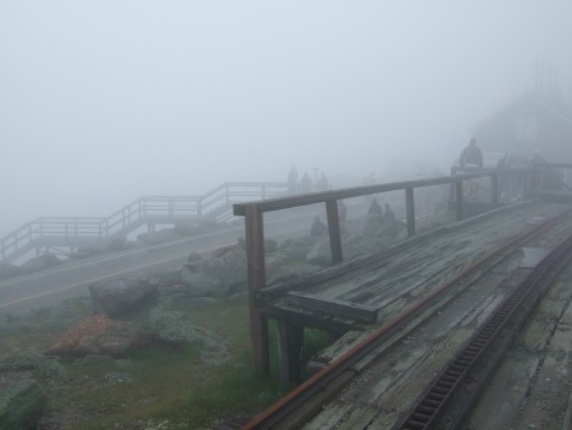
The last mile, well above the tree line, was a mental challenge to keep going. At this point, every rider was in their place. No one was passing anyone. We were all just pacing off each other.
I finally heard the cowbell which helped me. I tried to pedal a little harder to get to the bell, the symbolic top of the climb. I passed the woman ringing the bell and managed enough energy to thank her. Then I heard a whistle. This was a steam whistle. I thought this was really cool. They have a steam whistle sound when you get close. It was foggy, in the clouds really, and visibility was only about 50 meters. Although I couldn’t see where the whistle was located I then realized it was the Cog Railway train. So, OK, it wasn’t for me, but it helped.
One final steep climb and then I reached the summit. I thought. I looked up and could see parked cars and was looking for Ashley and Bryan but they were nowhere to be found. I didn’t see any people, just parked cars. But I knew I was close.
Many have warned about looking up to find the summit because it will defeat you. I never wanted to know how far I had left. I tried not to look up and I purposely played with the settings on my computers so I did not know time elapsed, distance elapsed, or time of day — anything that might tell me that I had too far remaining I wanted out of my mind. Only the Mile markers and the elevation markers, every thousand foot level, told me my progress.
I remember reading about the last 200 meters, a 22% grade up to the observatory. I thought I had read somewhere that it was optional and I already decided I would not do that. In fact, I could not do that. Reaching the summit would have to be enough.
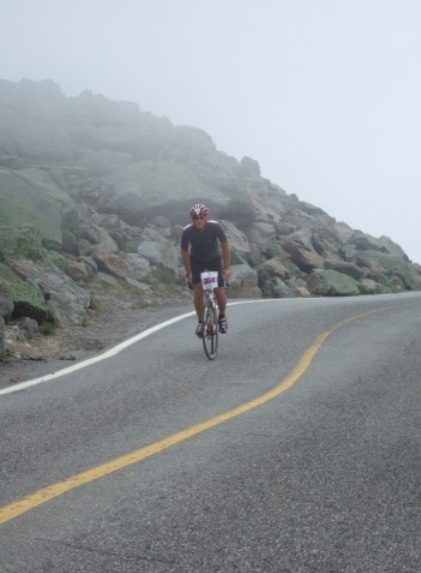
Now voices in the fog were yelling out encouragement and I was told I had just one more climb. Oh no! They made the 200-yard climb the finish line. I saw the steepness and felt my legs and thought there was no way I could make it up this climb.
This would be a right turn, steep climb, right turn, steeper climb, then a left turn switchback, an even steeper climb up to the finish line.
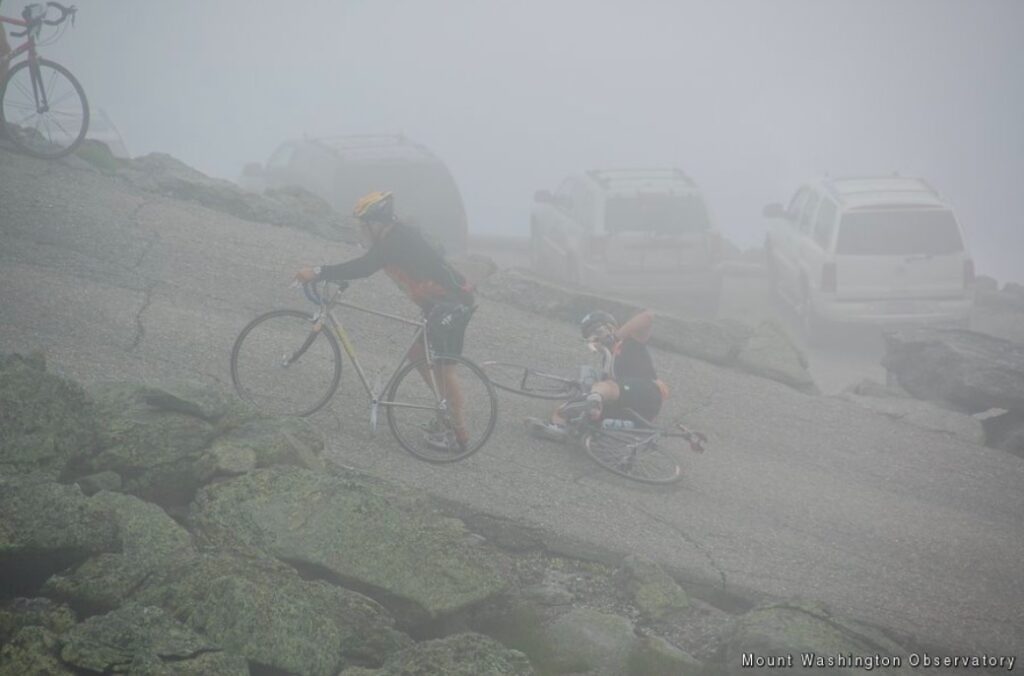
(Used with permission, Mount Washington Observatory_
I found the energy to get to the top of this section and a photographer was standing in my line. This wasn’t quite a 180º turn, maybe 170º, but it was a switchback. And most switchbacks have a steep inside line or a more gradual outside line. In this case, the outside line probably was 22%. Who knows what the inside line was? I could not take the inside path.

I simply didn’t have the energy to turn quickly and climb the inside line. I asked him to move. Maybe I yelled at him to move although I don’t think so. I was too tired to yell. He snapped the photo (above) then he jumped back. I turned in the switchback and thought my legs would stop and I would fall over as I looked at one final climb to the top.
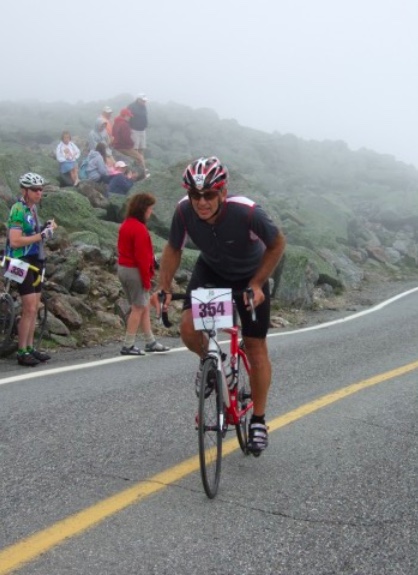
I reached for everything I had left which wasn’t much. I turned over the pedals with the last remaining energy I had and made it to the top. I saw Ashley and Bryan at the finish line cheering me on and taking pictures.
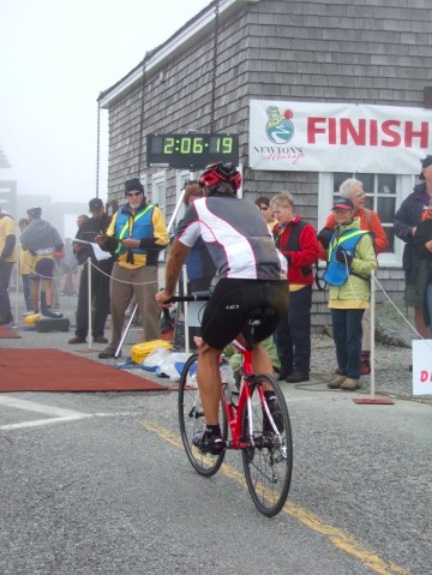
I started 15:00 behind the official clock so time was 1:51
There were two carpeted mats to ride over. The first was probably the timer and the second was a stopping area. I came to a stop and was grabbed by four or five people. They helped steady the bike and me. Someone clipped the timer chip off my fork. Another had me lower my head and placed a medal over my head. Still, another wrapped a blanket around me.
I went only a few more feet and a young man offered me water. I took it. I started to dismount and went to one knee. Ashley gave me a hug. I tried to talk but couldn’t. Part was hyperventilating and part was emotion. I was very upset that I had crashed, which in my mind, meant I didn’t pedal the entire route. But I did. No words would come out. Tears started to well in my eyes. I made it. The toughest climb in America, and maybe the world, and I made it.
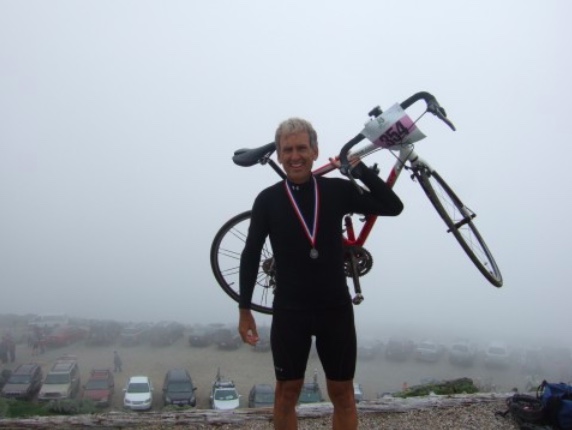
JULY 13, 2008 — WOODBRIDGE, VA
Home. Still can’t believe I made it. Although the soreness in my legs is a reminder.
If not completing my training ride up Hurricane Mountain Road on Thursday without stopping raised some doubt in my mind, then completing it on Friday bolstered me. I had decided that I went out too hard and fast on Thursday and should try it again on Friday.
Although it was only a day away from the race, I thought it would not hurt me physically to climb it again. It was just two miles in length. I risked quite a bit because if I failed again I would go to the big ride with no confidence. Instead, I got up at 6:00 a.m. and left at 7:00 to ride it again. This time I went slow in a low gear and when I needed the energy to get over that last 26% grade, I had it. I made it to the top. This gave me the confidence I needed for Saturday’s race.
Hurricane Mountain Road starts near North Conway, NH and rises 17% for two miles. Cross over the mountain and it descends to Maine.
After returning from my ride Friday morning, Ashley joined me and we went for a very relaxing 10-mile ride in the North Conway area.
I have a Garmin Edge 705 which I am still learning to use. It didn’t work perfectly but was good enough. Most of my stats and route were recorded. I turned it on at the Glen House which is across the highway from the toll road. Many riders were in the parking lot of the hotel warming up. I joined them. I turned it on to make sure it was working and it appeared to be although I see it did not capture cadence. It then goes “dead” for about 45 minutes (Timing) before starting it for the race. When I turned it or the timer off, it must have lost the elevation but appears to have got it correct when I started it to race. The elevation at the toll road is 1,563 feet.
For two hours my heart rate averaged 156. It peaked at 176 at the top section.
I still don’t know whether my gearing decision was right. And I could switch to something lower but it’s very difficult to test it other than find an eight-mile 12% grade. With high winds. And cold temperatures.
Both Garmin and my Trek wireless computer indicate that I added at least another half mile to my route by paperboying. Don’t know that I had the energy to ride without crisscrossing some of the steeper upper sections.
Approximately 700 cyclists will make it to the summit this year in the two races, Newton’s Revenge and the Mount Washington Auto Road Bicycle Hillclimb. Only 700. I didn’t have a great time but was faster than the first speed record in a car (2 hours, 10 min.). The current record in a car is 6 min. and 41.99 seconds.
The best map of the course I can find is on the Mt. Washington Bike Hillclimb Site.
The Mount Washington Observatory has a map that shows temperatures at different locations along the route.
A great blog by another rider who rode this in August 2004, was at Outdoor Online. Love his description that “every finisher is received like a survivor from some misbegotten Arctic expedition.” I would add that every finisher is received like an Olympic champion.
The day he road, many riders were blown off their bikes at the summit. The winds were relatively calm for my ride. No one that I know of was blown off their bike by the wind although the second-place finisher claims there were gusts to 50 mph.
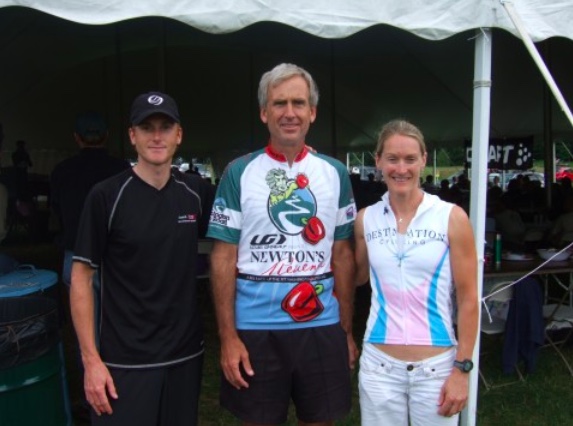
The true racers did well. Professional Anthony Colby won in 55:05. Wow! Phillip Gaimon of Tucker, Georgia, finished second in 56:01. But third was Austin Orth from North Conway. I think he was the rider that Ashley and I met last year and were going to give a ride back down the mountain. He finished in 1:02:39. The first place woman was Marti Shea. She finished in 1:14:22. She didn’t ride all the way either. Her chain broke 70 yards from the finish so she ran and pushed her bike that last grueling uphill section.
Anthony weighs 142 pounds. Can one have negative body fat?
Phil (Phil the Thrill) Gaimon is 6’1: and weighs 148 pounds. He lists his body fat as 4.2%. He also rode in the Tour of Pennsylvania last month, a race in which I worked as a volunteer for two stages. He is an amateur rider, trying to get a contract with a pro team, and is a funny writer.
There was an age group record set this day. Kenneth Cestone, 71 years old from Bennington, Vermont, shattered the Age 70-74 record by 15 minutes, lowering it to 1:29:59. Love that he beat 1:30 by one second. A rider like Ken gives all of us hope.
The last place finisher came in at 3:09. But he finished.
No activity I have ever tried pushed me like this one. There were no breaks. There were no resting places. Even a 100-mile ride features flats and downhills. On this one, you pedal or you crash. You pedal hard or you crash. And sometimes even if you pedal hard, you still crash. You gasp for breath in the upper elevations.
I have done many rides and it’s always nice to finish. But it is special to have people with you at the finish. My daughter, Ashley, came with me two years in a row to support me and this year brought her husband, Bryan. Part of my inspiration for keeping going came from knowing they were waiting for me at the summit. I looked for them when I crested the summit and didn’t find them until I made my last turn. They were at the finish line.
While at the summit, Bryan and I briefly tossed a frisbee (Discraft 175g Ultrastar to be exact) adding to the list of strange locations I have thrown the disc. Strangest and best: Across the Arctic Circle north of Rovaniemi, Finland. This is the home of Santa Claus.
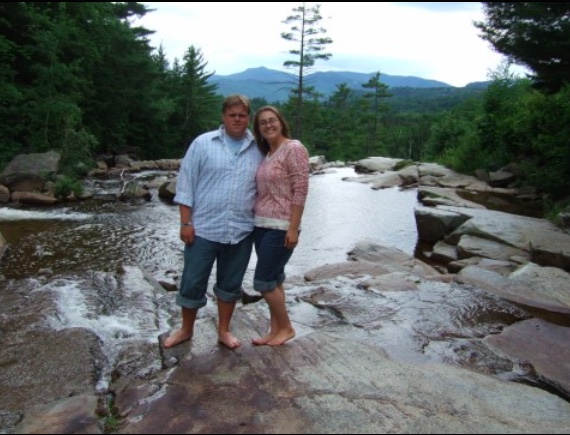
I can’t say for sure that if you believe you can climb it that you can but I can say with certainty that if you don’t believe you can do it then you can’t. And that is the mental struggle to keep positive through the pain and never allow yourself for even one second believe that you won’t make it.
In a matter of minutes after reaching the top I went from “never again” to “if I do it again.”
Mary Power, the events coordinator at the Auto Road says that it gets in your blood and you want to come back every year. I think she’s right. Besides, once you know you can climb it you can then work on strategies to improve your time.
If I do it again, I still would contemplate changing my gearing although I’m not sure what to. Even after the race people still contribute different ideas on what I should ride at the Mt. Washington Hillclimb Fourm. I definitely would find the biggest mountains in Virginia and Pennsylvania to ride 2-3 months before, every weekend. And I would do core training. My back hurt on the climb and that was simply because I spend a lot of time riding (it’s fun) and no time with core training (boring). Arriving two days early helped and I think I would even do three days next time.
If you go — registration for the August Mount Washington Auto Road Bicycle Hillclimb typically opens February 1. Check to be sure. If it sells out, and the past few years it has sold out in less than an hour, then the second race, Newton’s Revenge, is added in July. Next year’s date will be July 11, 2009. The August race is very hard to get into and takes 600 riders. I can’t imagine how crowded the mountain is then. For this year’s Newton’s race they had over 200 riders registered but 165 actually raced. Unless you think you can set a course record and want to pace against Tyler Hamilton or Tom Danielson, my suggestion is wait until February 2 and register for Newton’s Revenge. Everything’s the same except for the crowds. Registration information will be posted in September.
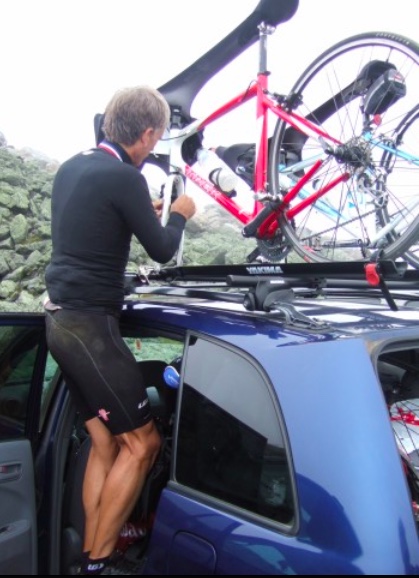
What I wore: At the bottom, I had Under Armour under my Louis Garneau gray/white jersey, hence the long sleeve look. But I raced in just the jersey — thus short sleeves. On the summit, I pulled on the Under Armour over my jersey, hence the all-black look. But since it had been in my back pocket on the ride up, it was pretty wet, “butt sweat” Ashley called it, so I took it off and pulled on my red Garneau jersey. By the bottom, I had switched to my Newton’s Revenge 2007 jersey. I purchased it last year but we never raced. I always felt I wasn’t worthy of wearing it until I finished the race. Now I can wear it.
In addition to the race jersey (for purchase) participants earned a “bumper” sticker – This Bike Climbed Mt. Washington – a long sleeve Newton’s Revenge t-shirt, medal and ribbon, event poster, and a real neat Polartec fleece blanket embroidered for the 2008 race. In addition, riders also got a typical rider’s goodie bag of cycling merchandise and coupons. We were treated to a Friday night pre-race pasta dinner and a Saturday noon Hart’s turkey dinner.
Everyone I met was great, even the winners (see picture). And I was surprised when I read the following post on the Newton’s Forum: On the dirt section, just before the 5-mile marker, someone crashed right in front of me, and fell into the ditch. Looked like a nasty crash – but most of my attention was taken in trying to avoid them. Hopefully the rider is okay – anyone know more details?
How nice was that? I responded that only my dignity was hurt but was restored by finishing. From a physical accomplishment, this was the greatest achievement in my life.
___Conversions — for my European and South American friends
1 Actual distance is 7.6 miles or 12.2 kilometers
2 140 or 150 pounds is 63.5 or 68 Kilos
3 70 mph is 113 kph
4 38 degrees is 3 Celsius
5 Lower elevation is 1,563′ or 476 meters. Elevation at the summit is 6,288′ or 1,917 meters
6 50 degrees is 10 Celsius
7 25 mph is 40 kph
8 115 degrees is 46 Celsius
9 190 pounds is 86.2 Kilos
10 4,000 feet is 1,219 meters
11 142 pounds is 64.4 Kilos
